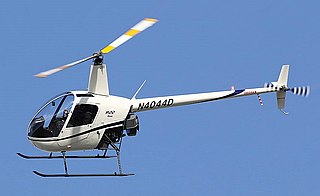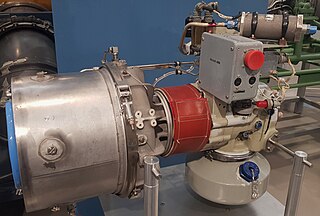The CarterCopter is an experimental compound autogyro developed by Carter Aviation Technologies in the United States to demonstrate slowed rotor technology. On 17 June 2005, the CarterCopter became the first rotorcraft to achieve mu-1 (μ=1), an equal ratio of airspeed to rotor tip speed, but crashed on the next flight and has been inoperable since. It is being replaced by the Carter Personal Air Vehicle.
The Robinson Helicopter Company, based at Zamperini Field in Torrance, California, is an American helicopter manufacturer. As of 2024, Robinson produces three models: the two-seat R22, the four-seat R44, both of which use Lycoming piston engines, and the five-seat R66, which use Rolls-Royce turbine engines.

The Robinson R22 is a two-seat, two-bladed, single-engined, light utility helicopter manufactured by Robinson Helicopter Company. It was designed in 1973 by Frank D. Robinson, and has been in production since 1979.

The Robinson R44 is a four-seat light helicopter produced by Robinson Helicopter Company since 1992. Derived from the company's two-seat Robinson R22, the R44 features hydraulically assisted flight controls and a larger engine. It was first flown on 31 March 1990 and received FAA certification in December 1992, with the first delivery in February 1993.

The Bell 407 is a four-blade, single-engine, civil utility helicopter. A derivative of the Bell 206L-4 LongRanger, the 407 uses the four-blade, soft-in-plane design rotor with composite hub developed for the United States Army's OH-58D Kiowa Warrior instead of the two-blade, semi-rigid, teetering rotor of the 206L-4.
Buford John Schramm, better-known as B.J. Schramm, was a businessman and developer of light personal helicopters. He was killed in the crash of a single-seat helicopter of his own design near Montour, about six miles southwest of Horseshoe Bend, Idaho. Schramm founded RotorWay Aircraft in 1961, a kit helicopter manufacturing company. At the time of his death he operated a company called Eagle R&D, based in Caldwell, Idaho, manufacturing a kit helicopter called the Helicycle.

The Guimbal Cabri G2 is a two-seat light helicopter produced by Hélicoptères Guimbal, and powered by a reciprocating engine. Designed by Bruno Guimbal, a former Eurocopter engineer, it had its origins in the 1980s, and the first demonstrator flew in 1992. Following the granting of regulatory approval, the Cabri entered commercial service in 2008. In addition to its use within the general aviation sector and as a training rotorcraft, the Cabri G2 has also been used as the basis for unmanned aerial vehicles (UAVs).

The Gyrodyne RON Rotorcycle was a tiny, single-seat helicopter designed under contract for the United States Navy. in the mid-1950s. It later was redesigned for a U.S. Marine Corps requirement for a small personal helicopter that would fulfill an array of roles, including observation, liaison, small unit tactical maneuvers, and which could be dropped to downed airmen behind enemy lines to facilitate their escape.

The Revolution Mini-500 is a 1990s American single-seat light helicopter, designed and built by Revolution Helicopter Corporation as a kit for homebuilding.

The Solar T62 Titan is an American gas turbine engine used mainly as a aircraft auxiliary power unit (APU), conventional power generator, turboprop engine for fixed-wing aircraft or turboshaft engine for helicopters. A new turbine version was developed as the Solar T66.

The Canadian Home Rotors Safari is a kit helicopter, produced by CHR International of Marianna, Florida, and formerly produced by Safari Helicopter of Ear Falls, Ontario.
The Famà Kiss 209M is an Italian ultralight two-seat helicopter, built from composite materials around a steel frame and with an optional retractable undercarriage. The moniker "Kiss" stands for "keep it stupidly simple", reflecting the philosophy of its designer, Nino Famà.
The RotorWay Helicopter Manufacturing Company, formerly called RotorWay International, was a manufacturer of kit helicopters located in Chandler, Arizona, United States. The company was founded by B.J. Schramm in 1961 as RotorWay Aircraft. RotorWay International was bought February 14, 2007 by a small group of investors comprising the company's upper-level management – Grant Norwitz, CEO, Bill Adams, COO, and Judy Craven, CFO. Of these, only Norwitz was still with the company in mid-2008.

The Bell 525 Relentless is an American super-medium-lift helicopter, under development by Bell Textron. The Bell 525 was unveiled at the 2012 Heli-Expo in Dallas, Texas in February 2012. The helicopter first flew on 1 July 2015. It is designed to transport up to 19 passengers. The aircraft is the first fly-by-wire civilian aircraft and suffered a crash of its prototype, and is still slowly working towards certification. As of 2024 Bell is still working towards completing flight certification but already has its first order.

The Composite Helicopters International KC 518 Adventourer is a composite fuselage, 5-6 place turbine kit helicopter.
The Hillberg Turbine Exec is an American helicopter turbine engine conversion kit for the piston-engined Rotorway Exec. It was designed and produced by Hillberg Helicopters of Fountain Valley, California. Now out of production, when it was available the kit was supplied for installation by amateur aircraft builders.
The Auroa Helicopters Auroa is a New Zealand helicopter designed and produced by Auroa Helicopters Limited of Manaia, Taranaki, introduced in 2013. The aircraft is supplied complete and ready-to-fly.
The LAE Ultrasport 496T is a Cypriot helicopter that was produced by LAE Helicopters Cyprus of Larnaca. Now out of production, when it was available the aircraft was supplied complete and ready-to-fly.
The Winner B150 is a Belgian helicopter that was designed and produced by Winner SBS of Dinant. Now out of production, when it was available the aircraft was supplied complete and ready-to-fly-aircraft or as a kit for amateur construction.

The Curti Zefhir is a two-seat light-single turbine-powered recreational or trainer helicopter designed and produced by Italian aircraft manufacturer Curti Aerospace. Development was partly funded by the European Commission. It performed its maiden flight in 2017 and was commercially launched at the April 2018 AERO Friedrichshafen. Curti aim to secure type certification of the Zefhir as an ultralight aircraft.











